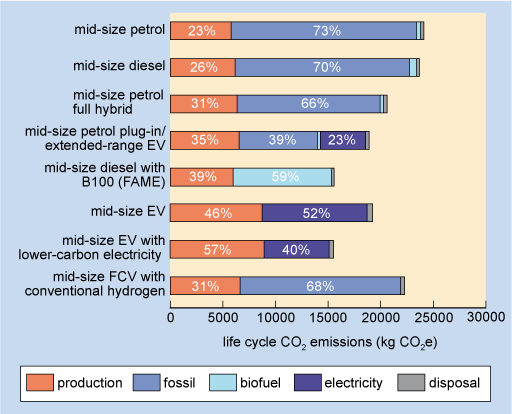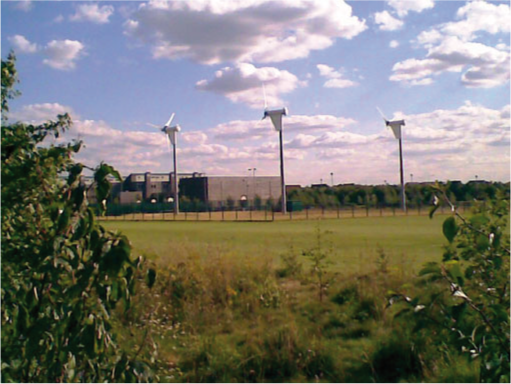8 Decarbonized transport
Environmental performance of low-carbon vehicles
We are entering a time when a whole range of new transport technologies and fuels is becoming available. Each of these, alone or in combination, has the potential to reduce CO2 emissions to some degree or another. Those based on fossil fuels (petrol, diesel, CNG and LPG) have a more limited potential because of the high carbon intensity of the feedstock fuel. The CO2 reduction potential of biofuels, electricity and hydrogen depends crucially on how the fuel in question is produced. In addition, some technologies (particularly those involving batteries) have issues around the low energy intensity of storage.
As noted earlier, life-cycle analysis indicates that the main environmental impact of petrol and diesel cars (some 70% or more) comes from their use of fuel. Yet for low-carbon vehicles the situation is different; CO2 from the production of the vehicle and manufacture of the fuel accounts for a higher proportion of emissions, with actual fuel in use accounting for a lower proportion.
Critics of hybrid, electric and fuel cell vehicles have focused on the higher embodied energy and CO2 emissions in the production of these vehicles and their fuel production and storage systems. A lot of claims and counterclaims have appeared in the technical and popular media. This issue was addressed in a recent LCA of different vehicle technologies (Patterson et al., 2011), the overall results of which are shown in Figure 21.

Key points are as follows.
- The proportion of emissions coming from the production of the vehicle and its fuels rises from around 25% for petrol/diesel to 31% for hybrids and fuel cell vehicles, to 35% for plug-in/extended-range EVs and 46% for EVs.
- The rise in production CO2 emissions for hybrids, EVs and plug-in/extended-range EVs is more than counterbalanced by a cut in the fuel emissions in use.
- The overall result is only a modest cut in overall CO2 emissions (about 20%) for hybrids, plug-in/extended-range EVs and BEVs.
- There is a substantial cut in overall CO2 emissions (nearly 40%) for BEVs using low-carbon electricity; likewise for appropriately sourced biodiesel cars.
- Fuel cell cars provide a very small improvement in CO2 emissions compared to petrol/diesel cars.
According to this LCA analysis, a typical medium-sized family car powered by petrol or diesel will produce around 24 tonnes of CO2 during its life cycle, while a hybrid will produce 21 tonnes. A comparable BEV will produce around 18 tonnes, which can be cut to just over 16 tonnes if lower-carbon electricity is sourced; an appropriately sourced biodiesel car also produces around 16 tonnes.
Decarbonisation potential
This LCA raises a second point. Critics have pointed out that the production of electricity and hydrogen today is highly dependent on fossil fuels, and that these technologies simply shift rather than eliminate CO2 emissions. This is reflected in the vehicle technologies LCA, which assumes a current mix of primary fuels for electricity (500 g CO2 per kWh) and that hydrogen is produced from natural gas. The 2011 study also notes the effect of decarbonizing energy production, making the following points.
- Reducing the carbon intensity of electricity from the present 500 g CO2 per kWh to 310 g CO2 per kWh would cut the total emissions produced by BEVs from 18 tonnes to 15 tonnes.
- Biofuels could also cut car emissions significantly.
- If hydrogen were produced from renewable sources (such as the wind turbines shown in Figure 22), its carbon intensity would be reduced by up to 90% (which would cut total lifetime emissions for a fuel cell vehicle down to about 9 tonnes of CO2). However, as noted earlier, this may not be the most efficient use of renewable energy.

This illustrates the crucial point about whether these production systems can be decarbonized or not. Fuels based on oil can only cut CO2 emissions by increasing efficiency (carbon capture is only viable in large plants – not on vehicles in use). Electricity and biofuel production can be decarbonized. Decarbonizing hydrogen is problematic if a long conversion chain is involved (see Activity 7.2).
This situation, of the low-carbon technologies providing only a limited improvement under current conditions, is something that is common at the early stages of a new technology or design. When first introduced, a new design may only just about match the performance of the incumbent design; yet it may have a much greater development potential, and it is the realization of that potential that is important. Critics (often with vested interests) focus on the present performance rather than on the future potential.
This LCA leads on to suggest that 'winning combinations' could be important. I have separately looked at biofuels and electricity, and both have issues around decarbonising production. Plug-in/extended-range EVs could combine decarbonized fuels from both sources. Overall, rather than being just a step towards another transport technology, if combined with cleaner liquid ICE fuels then they could represent a long-term sustainable vehicle technology in their own right. This is possibly a path that is less fraught than the one for BEVs and fuel cell vehicles, with their associated problems of long fuel conversion chains, range limitations and the need (particularly in the case of fuel cell vehicles) for new fuel supply networks.
